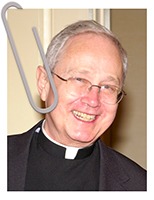Seeing what I had not seen
I once had the privilege of visiting a world-class museum with an artist. I had been to the museum many times before. This time, as we walked, sat, and looked, it was like I had never been there before. I saw so much for the first time! His insightful commentary helped me realize how much I had been “seeing but not seeing.”
I have since realized I really did not know how to see. Or should I say, how to focus and on what. [This post first appeared on FamVin]
I think we have all had the experience of not seeing that we have misspelled or even omitted a keyword in something we have written. We see what we expect to see, fill in the blanks or don’t see what is missing.
Apparently, such an experience is not limited to visiting museums and proofreading what we have written.
Jesus teaches Peter and his friends to see what they had not seen
Our first three Gospel writers tell us Jesus began his public ministry with the same mission statement: “The kingdom of God is at hand. Repent, and believe in the gospel.” It was in a way an essential part of his “stump speech.” (As Vincentians we pay particular attention to the words “to proclaim good news to the poor.”)
Immediately after, Jesus calls his first four followers, assuring the four fishermen, “I will make you fishers of men” (1:17b). In other words, “I’m changing the focus of your life. People, not fish, will now be your point of concentration.” They will be seeing things they’ve never seen before.
In a three-year apprenticeship, he tried to help them “notice” and “see” what he was focused on… invisible and marginalized people. They saw … but did not see… that Jesus welcomes…
- the ‘immoral’ (prostitutes and sinners)
- the ‘marginalized’ (lepers and sick people)
- ‘heretics’ (Samaritans and pagans)
- ‘collaborators’ (publicans and soldiers)
- ‘the weak’ and ‘the poor’ (who have neither power nor knowledge)
In Luke 17:21 he clarified what he was talking about: “behold, the kingdom of God is in the midst of you.” They needed the overshadowing of the Spirit to understand. Only when you imitate me and become one with those on the lower rungs of the social ladder, will you begin to notice others in that same position. Jesus expects only one thing of his followers: to see who and what he sees. Those who do so become “other Christs.”
Late in their apprenticeship, they were still focused on when he would “establish the kingdom” and who would have the first places. It would take his death and resurrection and the outpouring of his spirit to finally focus.
The scriptures helped Vincent see what he had not seen
Vincent literally devoured the scriptures and their picture of Jesus. In the second half of his life, he discovered the Jesus who paid attention to all those to whom God paid attention… EVERYONE. His conclusion was that Jesus expects only one thing of his followers: to see who and what he sees.
Is it any surprise that the two bedrock beliefs and foundation for Vincentian Spirituality are: first, God is the most real and the most precious reality there is, and second, this precious God lives in His people… each and every one of them, especially those who are not seen! When we “see” this we have already entered into the kingdom!
This is what gives us reason to metaphorically “take our shoes off” when we come into the presence of those we serve. Anyone wanting the key to the heart on fire in Vincent de Paul could not get much closer than meditating on these two convictions– two beliefs which, for Vincent, were wrapped one inside the other. They are the key to understanding why he says, “The poor are our Lords and masters!”
As people pass through our lives…
- Who do we see… but not see?
- How can paying attention to who Jesus sees, help us see as he sees?seeing but not


Thank you,Father Freund! I needed your reminder. Acting blind might seem like the easy way,but if I start seeing what Jesus is seeing, His grace will enable me to see with Godly vision.
I’m holding onto your meditation.
Most Gratefully,
Ed Ambrose